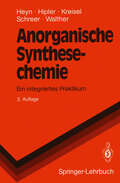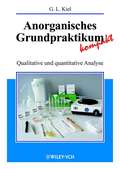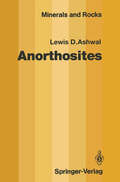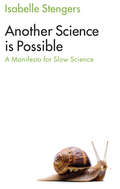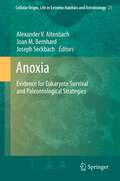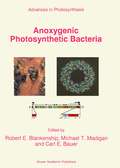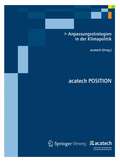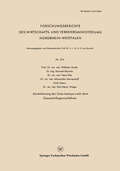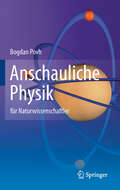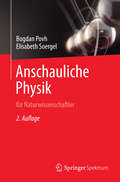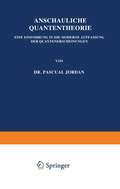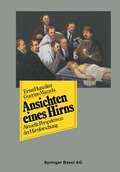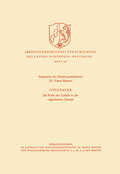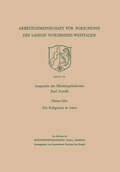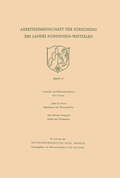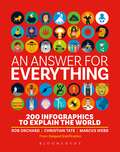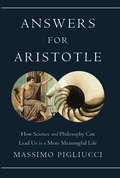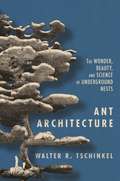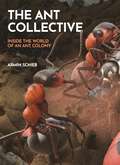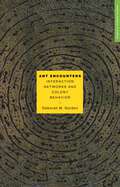- Table View
- List View
Anorganische Synthesechemie: Ein integriertes Praktikum (Springer-Lehrbuch)
by Bodo Heyn Bernd Hipler Günter Kreisel Heike Schreer Dirk WaltherAnorganisches Grundpraktikum kompakt: Qualitative und quantitative Analyse
by Gertrud KielMit Erfolg durchs anorganische Grundpraktikum! Erstmals präsentiert Gertrud Kiel ihr neues, preisgekröntes und unter Fachleuten anerkanntes Konzept für das Grundpraktikum Chemie in Buchform. Komprimiert auf das Wesentliche und innovativ in der Gestaltung liegt der Schwerpunkt dieses Werkes auf der Minimierung des Chemikalienverbrauchs - denn umweltbewußtes Experimentieren im Labor will gelernt sein! Die Lernhilfen umfassen: · Einführungen vor jedem Versuch · Hinweise und Abbildungen für die Durchführung · Angaben der Gefahrstoffsymbole verbunden mit den R-und S-Sätzen, damit lästiges Nachschlagen entfällt · Hilfen für die rechnerische Überprüfung der Reaktionsbedingungen sowie begleitende Tabellen mit den benötigten Konstanten · ein Kapitel zu kristallchemischen Reaktionen mit einem einzigartigen Bildatlas · einen Anhang mit sämtlichen, fürs Praktikum benötigten Lösungen und Feststoffen Wenn das Grundpraktikum so eingängig, umweltfreundlich und anschaulich dargeboten wird, dann macht Experimentieren nicht nur Spaß, sondern ist auch erfolgreich! Vorlagen für die Versuchsprotokolle finden Sie unter http://www.wiley-vch.de/books/info/3-527-30584-X/.
Anorthosites (Minerals, Rocks and Mountains #21)
by Lewis D. AshwalThe idea for a book on anorthosites came to me in January of 1986 while returning to Houston after holiday festivities in Dallas. The original idea was a review paper on anorthosites, but by the time I reached Houston, the subject material I contemplated induding was obviously too extensive for a single paper. The Director of the Lunar and Planetary Institute, Kevin Burke, was receptive to the idea of a book, and suggested that I contact Peter Wyllie, who serves as Editor of the Springer-Verlag series Minerals and Rocks. This effort, which I originally expected would take about a year, has taken nearly 6. I have many excuses- indolence, moving to another continent, other commitments, etc.-but the basic truth is that writing a book is much larger an undertaking than can be anticipated. Many people are aware of this, and I was duly forewarned. . But why write a book on anorthosites? This is a very good question, which I have considered from many angles. One rationale can be expressed in terms of a comparison between anorthosite and basalt. A first-order understanding of basalt genesis has been extant for many years. By contrast, there is little agreement about the origin of anorthosite. There are good reasons for studying and writing about basalt: it is the most abundant rock type on the Earth's surface, and is also plentiful on the surfaces of the other terrestrial planets.
Another Science is Possible: A Manifesto for Slow Science
by Isabelle StengersLike fast food, fast science is quickly prepared, not particularly good, and it clogs up the system. Efforts to tackle our most pressing issues have been stymied by conflict within the scientific community and mixed messages symptomatic of a rushed approach. What is more, scientific research is being shaped by the bubbles and crashes associated with economic speculation and the market. A focus on conformism, competitiveness, opportunism and flexibility has made it extremely difficult to present cases of failure to the public, for fear that it will lose confidence in science altogether. In this bold new book, distinguished philosopher Isabelle Stengers shows that research is deeply intertwined with broader social interests, which means that science cannot race ahead in isolation but must learn instead to slow down. Stengers offers a path to an alternative science, arguing that researchers should stop seeing themselves as the 'thinking, rational brain of humanity' and refuse to allow their expertise to be used to shut down the concerns of the public, or to spread the belief that scientific progress is inevitable and will resolve all of society's problems. Rather, science must engage openly and honestly with an intelligent public and be clear about the kind of knowledge it is capable of producing. This timely and accessible book will be of great interest to students, scholars and policymakers in a wide range of fields, as well anyone concerned with the role of science and its future.
Another Science is Possible: A Manifesto for Slow Science
by Isabelle StengersLike fast food, fast science is quickly prepared, not particularly good, and it clogs up the system. Efforts to tackle our most pressing issues have been stymied by conflict within the scientific community and mixed messages symptomatic of a rushed approach. What is more, scientific research is being shaped by the bubbles and crashes associated with economic speculation and the market. A focus on conformism, competitiveness, opportunism and flexibility has made it extremely difficult to present cases of failure to the public, for fear that it will lose confidence in science altogether. In this bold new book, distinguished philosopher Isabelle Stengers shows that research is deeply intertwined with broader social interests, which means that science cannot race ahead in isolation but must learn instead to slow down. Stengers offers a path to an alternative science, arguing that researchers should stop seeing themselves as the 'thinking, rational brain of humanity' and refuse to allow their expertise to be used to shut down the concerns of the public, or to spread the belief that scientific progress is inevitable and will resolve all of society's problems. Rather, science must engage openly and honestly with an intelligent public and be clear about the kind of knowledge it is capable of producing. This timely and accessible book will be of great interest to students, scholars and policymakers in a wide range of fields, as well anyone concerned with the role of science and its future.
Anoxia: Evidence for Eukaryote Survival and Paleontological Strategies (Cellular Origin, Life in Extreme Habitats and Astrobiology #21)
by Alexander V. Altenbach, Joan M. Bernhard and Joseph SeckbachANOXIA defines the lack of free molecular oxygen in an environment. In the presence of organic matter, anaerobic prokaryotes produce compounds such as free radicals, hydrogen sulfide, or methane that are typically toxic to aerobes. The concomitance of suppressed respiration and presence of toxic substances suggests these habitats are inhospitable to Eukaryota. Ecologists sometimes term such environments 'Death Zones'. This book presents, however, a collection of remarkable adaptations to anoxia, observed in Eukaryotes such as protists, animals, plants and fungi. Case studies provide evidence for controlled beneficial use of anoxia by, for example, modification of free radicals, use of alternative electron donors for anaerobic metabolic pathways, and employment of anaerobic symbionts. The complex, interwoven existence of oxic and anoxic conditions in space and time is also highlighted as is the idea that eukaryotic inhabitation of anoxic habitats was established early in Earth history.
Anoxygenic Photosynthetic Bacteria (Advances in Photosynthesis and Respiration #2)
by R. E. Blankenship Michael T. Madigan C. E. BauerAnoxygenic Photosynthetic Bacteria is a comprehensive volume describing all aspects of non-oxygen-evolving photosynthetic bacteria. The 62 chapters are organized into themes of: Taxonomy, physiology and ecology; Molecular structure of pigments and cofactors; Membrane and cell wall structure: Antenna structure and function; Reaction center structure and electron/proton pathways; Cyclic electron transfer; Metabolic processes; Genetics; Regulation of gene expression, and applications. The chapters have all been written by leading experts and present in detail the current understanding of these versatile microorganisms. The book is intended for use by advanced undergraduate and graduate students and senior researchers in the areas of microbiology, genetics, biochemistry, biophysics and biotechnology.
Anpassungsfähige Maschinenbelegungsplanung eines praxisorientierten hybriden Flow Shops
by Christin SchumacherIn der Produktionsplanung ist es eine tägliche Herausforderung, die beste Maschinenbelegung im Hinblick auf das Unternehmensziel zu finden. Dabei gilt es zu entscheiden, welches Produkt zu welchem Zeitpunkt auf welcher Maschine produziert werden soll. Für anwendungsorientierte Szenarien müssen eine Reihe von Nebenbedingungen sowie stochastische Einflüsse beachtet werden. Um ein für die Praxis möglichst relevantes Problem zu adressieren, wurden folgende immanente Charakteristika realistischer Maschinenbelegungsprobleme einbezogen: Maschinenausfälle, Unsicherheit in Prozessparametern, geplante Wartungen sowie Schwankungen der Produktionsbedarfe. Mithilfe einer entwickelten Software wird die Gesamtbearbeitungszeit in der Produktion minimiert. Am Beispiel eines hybriden Flow Shops aus der Praxis wird die Kombination von Operations Research, Simulationsexperimenten, Vorhersagen und Unternehmensprozessen evaluiert.
Anpassungsstrategien in der Klimapolitik (acatech POSITION)
by AcatechEine effektive Klimapolitik muss nicht nur unerwünschten Klimawandel vermeiden, sondern auch Anpassungsstrategien umfassen. Diese sollen die negativen Auswirkungen von Klimaveränderungen für Wirtschaft und Gesellschaft mindern. Die Entwicklung neuer Technologien, die weltweit einen Beitrag zur Anpassung an den Klimawandel leisten können, bietet auch wirtschaftliche Chancen für deutsche Unternehmen. Diese acatech POSITION stellt spezifische Klimafolgen in sechs Schlüsselbereichen dar, darunter natürliche Ressourcen, Stadtentwicklung, Energie- und Gesundheitsversorgung. So wird ein Beitrag zur gegenwärtigen Anpassungsdiskussion geleistet. acatech möchte sowohl die Risiken als auch die Chancen der Folgen des Klimawandels in Deutschland aufzeigen, das Bewusstsein für die Bedeutung von Anpassungsmaßnahmen in der gesellschaftlichen Diskussion stärken und mit seinen Handlungsempfehlungen zur Entwicklung nachhaltiger Anpassungsstrategien beitragen.
Anreicherung der Uran-Isotope nach dem Gaszentrifugenverfahren (Forschungsberichte des Wirtschafts- und Verkehrsministeriums Nordrhein-Westfalen #510)
by Wilhelm Groth Konrad Beyerle Hans Ihle Alexander Murrenhoff Erich Nann Karl-Heinz WelgeAnsätze eines Global Health Systems oder Krisenmanagement in der COVID-19 Pandemie (BestMasters)
by Emily Moira LamprechtMit Anlauf der ersten COVID-19-Impfprogramme stellte sich schnell heraus, dass Teile der Welt einen leichteren Zugang zu den unter Hochdruck entwickelten Impfstoffen erhielten als andere. Trotz der globalen Impfinitiative COVAX, die es sich zum Ziel gesetzt hatte, eine gerechte Verteilung für alle zu erreichen, bildete sich ein ausgeprägtes Nord-Süd-Gefälle. Eine derart ungerechte Verteilung der Impfstoffe wirft nicht nur Fragen internationaler Gerechtigkeit auf, sondern gefährdet die Sicherheit aller Menschen weltweit, indem sie für alle Länder eine effektive Bekämpfung der Pandemie erschwert oder gar verhindert. Das Buch untersucht daher Faktoren, die zur beobachteten ungleichen Verteilung geführt haben und zeigt auf, wo Ansprüche an Gerechtigkeit noch nicht erfüllt wurden. Angelehnt an die Forschungserkenntnisse endet die Autorin mit Empfehlungen für die Politik, um bei zukünftigen pandemischen Lagen effektivere und gerechtere Maßnahmen treffen zu können. Für die Analyse wurden sechs Expertenpanels des Harvard Global Health Institute anhand der qualitativen Inhaltsanalyse nach Mayring (2015) theoriegeleitet ausgewertet. Eingang finden alle Phasen – von der Entwicklung, Produktion und Verteilung bis zur Impfung vor Ort.
Anschauliche Physik: für Naturwissenschaftler
by Bogdan PovhDer reich bebilderte Band bietet einen schnellen Einstieg in die moderne Physik – bis hin zu den neuesten Erkenntnissen über das Universum. Dem Autor gelingt es, einen intuitiven Zugang zum physikalischen Denken zu eröffnen. Er verbindet jede wichtige mathematische Formel mit Beispielen, die die Anwendung veranschaulichen. So liefert er seinen Lesern die Basis, um selbst physikalische Probleme lösen zu können. Der Band richtet sich an Studienanfänger im Bereich Naturwissenschaften ebenso wie an Gymnasial- und Fachschullehrer und an Abiturienten.
Anschauliche Physik: für Naturwissenschaftler
by Bogdan Povh Elisabeth SoergelDas vorliegende Buch richtet sich an Naturwissenschaftler mit ein- bis zweisemestriger Physik im Nebenfach sowie an Lehrer in Gymnasien und Fachschulen. Die Autoren sind als hervorragende Hochschullehrer bekannt und mit diesem Buch gelingt es ihnen, dem Leser das intuitive physikalische Denken zu vermitteln. Dies wird durch viele anschauliche Bilder unterstützt. Zu jeder wichtigen mathematischen Formel wird an Hand von Beispielen ihre Anwendung gezeigt und damit auch die Basis, selbst Probleme zu lösen, gegeben. Die Darstellung ist prägnant, trotzdem vermittelt sie dem Leser den heutigen Stand der Physik. Studenten, Lehrer und auch an den Naturwissenschaften Interessierte werden hier einen schnellen und effektiven Zugang zur modernen Physik finden.
Anschauliche Quantentheorie: Eine Einführung in die Moderne Auffassung der Quantenerscheinungen
by P. JordanDieser Buchtitel ist Teil des Digitalisierungsprojekts Springer Book Archives mit Publikationen, die seit den Anfängen des Verlags von 1842 erschienen sind. Der Verlag stellt mit diesem Archiv Quellen für die historische wie auch die disziplingeschichtliche Forschung zur Verfügung, die jeweils im historischen Kontext betrachtet werden müssen. Dieser Titel erschien in der Zeit vor 1945 und wird daher in seiner zeittypischen politisch-ideologischen Ausrichtung vom Verlag nicht beworben.
Ansichten eines Hirns: Aktuelle Perspektiven der Hirnforschung
by HUNZIKER Guerino MazzolaAnsichten eines Hirns ist das Resultat einer Informationsreise zu den wichtigsten europäischen Zentren der Hirnforschung. Wir konnten da raus die aktuellsten Perspektiven der Spezialisten in Erfahrung bringen. Es galt, die wesentlichen Erkenntnisse der Fachleute aus der Fülle ihrer Arbeiten herauszuschälen, miteinander in Beziehung zu setzen und daraus - so weit wie möglich - ein Netz von Zusammenhängen zu knüpfen. Der Kern dieser Aufgabe bestand darin, den babylonischen Sprachdschungel einander fremd geworden er Einzelwissenschaftler zu entwirren, um Ihnen den Weg zu einem künftigen Dialog zu ebnen. Angesichts der Tatsache, daß es in der Hirnforschung ums Eigentliche des Menschseins geht, ist ein Austausch von Einzelansichten kein Luxus, sondern wissenschaftliche und gesellschaftliche Notwendigkeit. Da die vielfältigen Ansichten des Gehirns im Grund immer auch die grundlegende Arbeitsweise eben dieses Denk-und Gefühlsorgans offen baren, sind wir zur Überzeugung gelangt, daß sich wirkliche Erkenntnis se und die Faszination des Gegenstandes auch umgangssprachlich prä zise und lustvoll vermitteln lassen.
Ansprache des Ministerpräsidenten / Die Rolle des Zufalls in der organischen Chemie (Arbeitsgemeinschaft für Forschung des Landes Nordrhein-Westfalen #119)
by Franz MeyersAnsprache des Ministerpräsidenten Karl Arnold. Die Religionen in Asien (Arbeitsgemeinschaft für Forschung des Landes Nordrhein-Westfalen #28)
by Karl ArnoldAnsprache des Ministerpräsidenten. Staatsbürger und Wissenschaftler. Antike und Christentum (Arbeitsgemeinschaft für Forschung des Landes Nordrhein-Westfalen #17)
by Karl Heinrich ConantAn Answer for Everything: 200 Infographics to Explain the World
by Delayed GratificationWhat's the best book ever written?What would happen if we all stopped eating meat?What's the secret to living past 110?And what actually is the best thing since sliced bread?In An Answer For Everything, 200 of the world's most intriguing questions are settled once and for all through beautiful and brilliant infographics. The results will leave you shocked, informed and thoroughly entertained.Created by the team behind the award-winning Delayed Gratification magazine, these compelling, darkly funny data visualisations will change the way you think about ... everything
Answers for Aristotle: How Science and Philosophy Can Lead Us to A More Meaningful Life
by Massimo PigliucciHow should we live? According to philosopher and biologist Massimo Pigliucci, the greatest guidance to this essential question lies in combining the wisdom of 24 centuries of philosophy with the latest research from 21st century science. In Answers for Aristotle, Pigliucci argues that the combination of science and philosophy first pioneered by Aristotle offers us the best possible tool for understanding the world and ourselves. As Aristotle knew, each mode of thought has the power to clarify the other: science provides facts, and philosophy helps us reflect on the values with which to assess them. But over the centuries, the two have become uncoupled, leaving us with questions—about morality, love, friendship, justice, and politics—that neither field could fully answer on its own. Pigliucci argues that only by rejoining each other can modern science and philosophy reach their full potential, while we harness them to help us reach ours. Pigliucci discusses such essential issues as how to tell right from wrong, the nature of love and friendship, and whether we can really ever know ourselves—all in service of helping us find our path to the best possible life. Combining the two most powerful intellectual traditions in history, Answers for Aristotle is a remarkable guide to discovering what really matters and why.
Ant Architecture: The Wonder, Beauty, and Science of Underground Nests
by Walter R. TschinkelAn unprecedented look at the complex and beautiful world of underground ant architectureWalter Tschinkel has spent much of his career investigating the hidden subterranean realm of ant nests. This wonderfully illustrated book takes you inside an unseen world where thousands of ants build intricate homes in the soil beneath our feet.Tschinkel describes the ingenious methods he has devised to study ant nests, showing how he fills a nest with plaster, molten metal, or wax and painstakingly excavates the cast. He guides you through living ant nests chamber by chamber, revealing how nests are created and how colonies function. How does nest architecture vary across species? Do ants have "architectural plans"? How do nests affect our environment? As he delves into these and other questions, Tschinkel provides a one-of-a-kind natural history of the planet's most successful creatures and a compelling firsthand account of a life of scientific discovery.Offering a unique look at how simple methods can lead to pioneering science, Ant Architecture addresses the unsolved mysteries of underground ant nests while charting new directions for tomorrow’s research, and reflects on the role of beauty in nature and the joys of shoestring science.
Ant Architecture: The Wonder, Beauty, and Science of Underground Nests
by Walter R. TschinkelAn unprecedented look at the complex and beautiful world of underground ant architectureWalter Tschinkel has spent much of his career investigating the hidden subterranean realm of ant nests. This wonderfully illustrated book takes you inside an unseen world where thousands of ants build intricate homes in the soil beneath our feet.Tschinkel describes the ingenious methods he has devised to study ant nests, showing how he fills a nest with plaster, molten metal, or wax and painstakingly excavates the cast. He guides you through living ant nests chamber by chamber, revealing how nests are created and how colonies function. How does nest architecture vary across species? Do ants have "architectural plans"? How do nests affect our environment? As he delves into these and other questions, Tschinkel provides a one-of-a-kind natural history of the planet's most successful creatures and a compelling firsthand account of a life of scientific discovery.Offering a unique look at how simple methods can lead to pioneering science, Ant Architecture addresses the unsolved mysteries of underground ant nests while charting new directions for tomorrow’s research, and reflects on the role of beauty in nature and the joys of shoestring science.
The Ant Collective: Inside the World of an Ant Colony
by Armin SchiebAnts come alive on this fabulously illustrated journey into the heart of a bustling colonyAnts share a vibrant and complex communal life and remarkable abilities to communicate with each other. The Ant Collective presents the world of ants as you have never seen it before, using hyperrealistic, computer-generated imagery that shows 3D-like views of activities inside and outside a thriving nest of red wood ants. With chapters on topics ranging from the establishment and construction of the nest to the birth of an ant trail and the relocation of a colony, this one-of-a-kind book brilliantly integrates informative descriptions with the illustrations, drawing on the latest science to reveal the innermost workings of the colony and enabling you to explore the ant collective as if you are there.Features a wealth of naturalistic 3D-like illustrations and schematic infographicsDepicts the anatomy of ants, the architecture of their nests, their interactions with the environment and other animals, and their collective social behaviorFollows the annual life cycle of the colonyProvides an incredible up-close look at ant reproduction, defense, foraging, nesting, division of labor, and morePacked with information about the biology, ecology, and communication skills of these marvelous insects
Ant Encounters: Interaction Networks and Colony Behavior
by Deborah M. GordonHow do ant colonies get anything done, when no one is in charge? An ant colony operates without a central control or hierarchy, and no ant directs another. Instead, ants decide what to do based on the rate, rhythm, and pattern of individual encounters and interactions--resulting in a dynamic network that coordinates the functions of the colony. Ant Encounters provides a revealing and accessible look into ant behavior from this complex systems perspective. Focusing on the moment-to-moment behavior of ant colonies, Deborah Gordon investigates the role of interaction networks in regulating colony behavior and relations among ant colonies. She shows how ant behavior within and between colonies arises from local interactions of individuals, and how interaction networks develop as a colony grows older and larger. The more rapidly ants react to their encounters, the more sensitively the entire colony responds to changing conditions. Gordon explores whether such reactive networks help a colony to survive and reproduce, how natural selection shapes colony networks, and how these structures compare to other analogous complex systems. Ant Encounters sheds light on the organizational behavior, ecology, and evolution of these diverse and ubiquitous social insects.
Ant Encounters: Interaction Networks and Colony Behavior (PDF)
by Deborah M. GordonHow do ant colonies get anything done, when no one is in charge? An ant colony operates without a central control or hierarchy, and no ant directs another. Instead, ants decide what to do based on the rate, rhythm, and pattern of individual encounters and interactions--resulting in a dynamic network that coordinates the functions of the colony. Ant Encounters provides a revealing and accessible look into ant behavior from this complex systems perspective. Focusing on the moment-to-moment behavior of ant colonies, Deborah Gordon investigates the role of interaction networks in regulating colony behavior and relations among ant colonies. She shows how ant behavior within and between colonies arises from local interactions of individuals, and how interaction networks develop as a colony grows older and larger. The more rapidly ants react to their encounters, the more sensitively the entire colony responds to changing conditions. Gordon explores whether such reactive networks help a colony to survive and reproduce, how natural selection shapes colony networks, and how these structures compare to other analogous complex systems. Ant Encounters sheds light on the organizational behavior, ecology, and evolution of these diverse and ubiquitous social insects.
